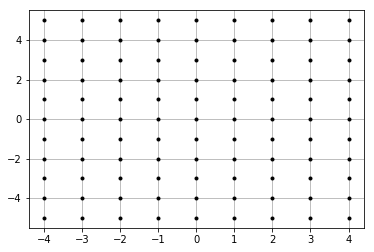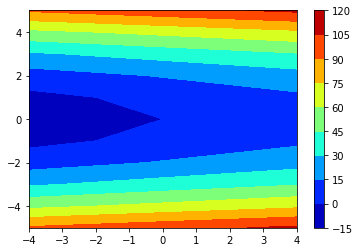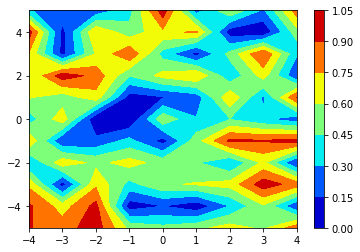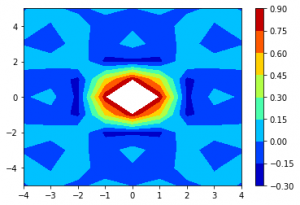Numpy Meshgrid函数
numpy.meshgrid函数用于从两个给定的一维数组中创建一个矩形网格,代表笛卡尔索引或矩阵索引。Meshgrid函数在某种程度上受到MATLAB的启发。
考虑上图,X轴的范围是-4到4,Y轴的范围是-5到5。所以图中总共有(9*11)=99个点,每个点都有一个X坐标和一个Y坐标。对于任何平行于X轴的直线,标记的点的X坐标分别是-4,-3,-2,-1,0,1,2,3,4。另一方面,对于任何平行于Y轴的线,标记点的Y坐标从下到上分别是-5, -4, -3, -2, -1, 0, 1, 2, 3, 4, 5。numpy.meshgrid函数返回两个二维数组,代表所有点的X和Y坐标。

示例:
输入
x = [-4, -3, -2, -1, 0, 1, 2, 3, 4]
y = [-5, -4, -3, -2, -1, 0, 1, 2, 3, 4, 5]
输出
x_1 = array([[-4., -3., -2., -1., 0., 1., 2., 3., 4.],
[-4., -3., -2., -1., 0., 1., 2., 3., 4.],
[-4., -3., -2., -1., 0., 1., 2., 3., 4.],
[-4., -3., -2., -1., 0., 1., 2., 3., 4.],
[-4., -3., -2., -1., 0., 1., 2., 3., 4.],
[-4., -3., -2., -1., 0., 1., 2., 3., 4.],
[-4., -3., -2., -1., 0., 1., 2., 3., 4.],
[-4., -3., -2., -1., 0., 1., 2., 3., 4.],
[-4., -3., -2., -1., 0., 1., 2., 3., 4.],
[-4., -3., -2., -1., 0., 1., 2., 3., 4.],
[-4., -3., -2., -1., 0., 1., 2., 3., 4.]])
y_1 = array([[-5., -5., -5., -5., -5., -5., -5., -5., -5.],
[-4., -4., -4., -4., -4., -4., -4., -4., -4.],
[-3., -3., -3., -3., -3., -3., -3., -3., -3.],
[-2., -2., -2., -2., -2., -2., -2., -2., -2.],
[-1., -1., -1., -1., -1., -1., -1., -1., -1.],
[ 0., 0., 0., 0., 0., 0., 0., 0., 0.],
[ 1., 1., 1., 1., 1., 1., 1., 1., 1.],
[ 2., 2., 2., 2., 2., 2., 2., 2., 2.],
[ 3., 3., 3., 3., 3., 3., 3., 3., 3.],
[ 4., 4., 4., 4., 4., 4., 4., 4., 4.],
[ 5., 5., 5., 5., 5., 5., 5., 5., 5.]])
输入
x = [0, 1, 2, 3, 4, 5]
y = [2, 3, 4, 5, 6, 7, 8]
输出
x_1 = array([[0., 1., 2., 3., 4., 5.],
[0., 1., 2., 3., 4., 5.],
[0., 1., 2., 3., 4., 5.],
[0., 1., 2., 3., 4., 5.],
[0., 1., 2., 3., 4., 5.],
[0., 1., 2., 3., 4., 5.],
[0., 1., 2., 3., 4., 5.]])
y_1 = array([[2., 2., 2., 2., 2., 2.],
[3., 3., 3., 3., 3., 3.],
[4., 4., 4., 4., 4., 4.],
[5., 5., 5., 5., 5., 5.],
[6., 6., 6., 6., 6., 6.],
[7., 7., 7., 7., 7., 7.],
[8., 8., 8., 8., 8., 8.]]
以下是代码。
# Sample code for generation of first example
import numpy as np
# from matplotlib import pyplot as plt
# pyplot imported for plotting graphs
x = np.linspace(-4, 4, 9)
# numpy.linspace creates an array of
# 9 linearly placed elements between
# -4 and 4, both inclusive
y = np.linspace(-5, 5, 11)
# The meshgrid function returns
# two 2-dimensional arrays
x_1, y_1 = np.meshgrid(x, y)
print("x_1 = ")
print(x_1)
print("y_1 = ")
print(y_1)
输出:
x_1 =
[[-4. -3. -2. -1. 0. 1. 2. 3. 4.]
[-4. -3. -2. -1. 0. 1. 2. 3. 4.]
[-4. -3. -2. -1. 0. 1. 2. 3. 4.]
[-4. -3. -2. -1. 0. 1. 2. 3. 4.]
[-4. -3. -2. -1. 0. 1. 2. 3. 4.]
[-4. -3. -2. -1. 0. 1. 2. 3. 4.]
[-4. -3. -2. -1. 0. 1. 2. 3. 4.]
[-4. -3. -2. -1. 0. 1. 2. 3. 4.]
[-4. -3. -2. -1. 0. 1. 2. 3. 4.]
[-4. -3. -2. -1. 0. 1. 2. 3. 4.]
[-4. -3. -2. -1. 0. 1. 2. 3. 4.]]
y_1 =
[[-5. -5. -5. -5. -5. -5. -5. -5. -5.]
[-4. -4. -4. -4. -4. -4. -4. -4. -4.]
[-3. -3. -3. -3. -3. -3. -3. -3. -3.]
[-2. -2. -2. -2. -2. -2. -2. -2. -2.]
[-1. -1. -1. -1. -1. -1. -1. -1. -1.]
[ 0. 0. 0. 0. 0. 0. 0. 0. 0.]
[ 1. 1. 1. 1. 1. 1. 1. 1. 1.]
[ 2. 2. 2. 2. 2. 2. 2. 2. 2.]
[ 3. 3. 3. 3. 3. 3. 3. 3. 3.]
[ 4. 4. 4. 4. 4. 4. 4. 4. 4.]
[ 5. 5. 5. 5. 5. 5. 5. 5. 5.]]
meshgrid输出的坐标也可以用于在给定的坐标范围内绘制函数。
An Ellipse:
ellipse = xx * 2 + 4 * yy**2
plt.contourf(x_1, y_1, ellipse, cmap = 'jet')
plt.colorbar()
plt.show()
输出:

Random Data:
random_data = np.random.random((11, 9))
plt.contourf(x_1, y_1, random_data, cmap = 'jet')
plt.colorbar()
plt.show()
输出:

一个正弦函数:
sine = (np.sin(x_1**2 + y_1**2))/(x_1**2 + y_1**2)
plt.contourf(x_1, y_1, sine, cmap = 'jet')
plt.colorbar()
plt.show()
输出:

我们观察到,x_1是一个行重复矩阵,而y_1是一个列重复矩阵。x_1的一行和y_1的一列就足以确定所有点的位置,因为其他的值会被不断地重复。因此,我们可以将上述代码编辑如下。
x_1, y_1 = np.Meshgrid(x, y, sparse = True)
这将产生以下输出。
x_1 = [[-4. -3. -2. -1. 0. 1. 2. 3. 4.]]
y_1 = [[-5.]
[-4.]
[-3.]
[-2.]
[-1.]
[ 0.]
[ 1.]
[ 2.]
[ 3.]
[ 4.]
[ 5.]]
x_1的形状从(11,9)变为(1,9),y_1的形状从(11,9)变为(11,1)。
然而,矩阵的索引是不同的。实际上,它与笛卡尔的索引完全相反。

对于上图所示的矩阵,对于一个给定的行,Y坐标从左到右增加为0、1、2、3,而对于一个给定的列,X坐标从上到下增加为0、1、2。
从Matrix索引中返回的两个二维数组将是前面程序生成的数组的转置。以下代码可用于获得矩阵索引。
# Sample code for generation of Matrix indexing
import numpy as np
x = np.linspace(-4, 4, 9)
# numpy.linspace creates an array
# of 9 linearly placed elements between
# -4 and 4, both inclusive
y = np.linspace(-5, 5, 11)
# The meshgrid function returns
# two 2-dimensional arrays
x_1, y_1 = np.meshgrid(x, y)
x_2, y_2 = np.meshgrid(x, y, indexing = 'ij')
# The following 2 lines check if x_2 and y_2 are the
# transposes of x_1 and y_1 respectively
print("x_2 = ")
print(x_2)
print("y_2 = ")
print(y_2)
# np.all is Boolean and operator;
# returns true if all holds true.
print(np.all(x_2 == x_1.T))
print(np.all(y_2 == y_1.T))
输出:
x_2 =
[[-4. -4. -4. -4. -4. -4. -4. -4. -4. -4. -4.]
[-3. -3. -3. -3. -3. -3. -3. -3. -3. -3. -3.]
[-2. -2. -2. -2. -2. -2. -2. -2. -2. -2. -2.]
[-1. -1. -1. -1. -1. -1. -1. -1. -1. -1. -1.]
[ 0. 0. 0. 0. 0. 0. 0. 0. 0. 0. 0.]
[ 1. 1. 1. 1. 1. 1. 1. 1. 1. 1. 1.]
[ 2. 2. 2. 2. 2. 2. 2. 2. 2. 2. 2.]
[ 3. 3. 3. 3. 3. 3. 3. 3. 3. 3. 3.]
[ 4. 4. 4. 4. 4. 4. 4. 4. 4. 4. 4.]]
y_2 =
[[-5. -4. -3. -2. -1. 0. 1. 2. 3. 4. 5.]
[-5. -4. -3. -2. -1. 0. 1. 2. 3. 4. 5.]
[-5. -4. -3. -2. -1. 0. 1. 2. 3. 4. 5.]
[-5. -4. -3. -2. -1. 0. 1. 2. 3. 4. 5.]
[-5. -4. -3. -2. -1. 0. 1. 2. 3. 4. 5.]
[-5. -4. -3. -2. -1. 0. 1. 2. 3. 4. 5.]
[-5. -4. -3. -2. -1. 0. 1. 2. 3. 4. 5.]
[-5. -4. -3. -2. -1. 0. 1. 2. 3. 4. 5.]
[-5. -4. -3. -2. -1. 0. 1. 2. 3. 4. 5.]]
True
True
sparse = True也可以在矩阵索引的Meshgrid函数中加入。在这种情况下,x_2的形状将从(9,11)变为(9,1),y_2的形状将从(9,11)变为(1,11)。
 极客教程
极客教程